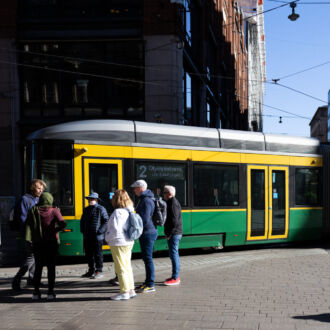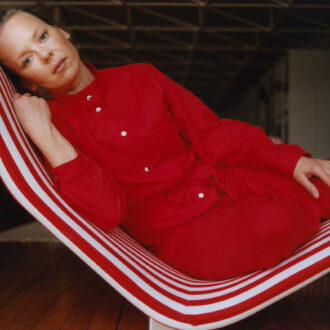Finland is an easy country to visit. Finnish customs and manners are clearly European, with only a few national variations, and attitudes are liberal. There is very little chance of a visitor committing fundamental social gaffes or breaches of etiquette that would fatally damage relations between himself and his hosts. Such breaches are viewed by Finns with equanimity if committed by their own countrymen and with understanding or amusement if committed by foreigners. Codes of behaviour are fairly relaxed, and reputations – good or bad – are built up over time as the result of personal actions rather than conforming to norms or standards. It is difficult in Finland to make or break a reputation with a single social blunder.
Finland is a country where considerable weight is attached to the spoken word – words are chosen carefully and for the purpose of delivering a message. Indeed, there are very few other culture-specific considerations that visitors need be aware of. Finns place great value on words, which is reflected in the tendency to say little and avoid ‘unnecessary’ small talk. As the Chinese proverb puts it, “Your speech should be better than silence, if it is not, be silent.”
Identity
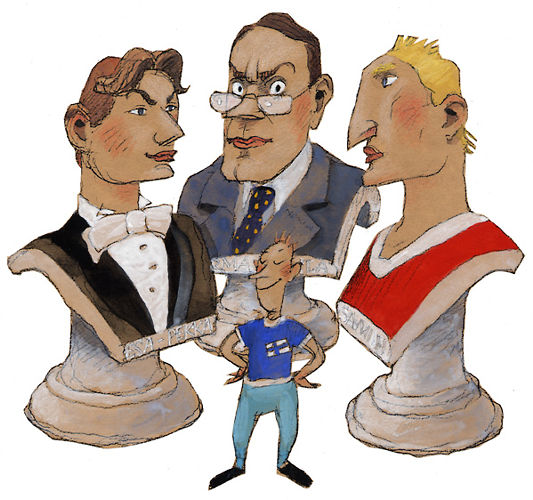
Finns have a very strong sense of national identity. This is rooted in the country’s history – particularly its honourable wartime achievements and significant sporting merits – and is today nurtured by pride in Finland’s high-tech expertise. Being realists, Finns do not expect foreigners to know a lot about their country and its prominent people, past or present, so they will be pleased if a visitor is familiar with at least some of the milestones of Finnish history or the sports careers of Paavo Nurmi and Lasse Viren. Finns would be happy if visitors knew something about the achievements of Finnish rally drivers and Formula 1 stars, or if they knew that footballers Jari Litmanen and Sami Hyypiä are Finns. Culturally oriented Finns will take it for granted that like-minded visitors are familiar not only with Sibelius but with contemporary composers Kaija Saariaho and Magnus Lindberg, and orchestral conductors Esa-Pekka Salonen, Jukka-Pekka Saraste, Sakari Oramo and Osmo Vänskä. While Finns are aware that Nokia is often mistakenly thought to be a Japanese company, this misconception is viewed forgivingly but with pity. They are proud that Linus Torvalds, the inventor of Linux, is a Finn.
Visitors should also be prepared to encounter the other side of the Finnish national character: Finns are chronically insecure about whether the wider world is aware of the achievements of this northern nation. Finns love reading things written about them abroad, and visitors should not feel uncomfortable being asked repeatedly what they think of Finland. However, although Finns are ready enough to criticize their own country, they do not necessarily wish to hear visitors doing so.
Religion
As far as religion is concerned, there are very few dangers for visitors to Finland, even on subjects that in other cultures might be particularly sensitive. Most Finns belong formally to the Evangelical-Lutheran Church (about 83%), while 1.1% belong to the Finnish Orthodox Church; but people in general are fairly secular in their views. Despite this, the Church and its ministers are held in high esteem, and personal religious views are respected. It is difficult to observe differences between believers and everyone else in everyday life, except perhaps that the former lead more abstemious lives.
Gender
There is a high degree of equality between the sexes in Finland, as can be seen in the relatively high number of women holding advanced positions in politics and other areas of society.
There are numerous women in academic posts, and in recent years visiting businessmen have also found increasing numbers of ‘the fairer sex’ on the other side of the negotiating table. The Evangelical-Lutheran Church of Finland accepts the ordination of women, and there are women priests in numerous parishes. The first female Finnish bishop in the Evangelical Lutheran Church of Finland was Irja Askola, bishop of Helsinki from 2010 to 2017.
Chauvinistic or patronizing attitudes towards women are generally considered unacceptable, although such attitudes do persist in practice. Women do appreciate traditional courtesy, although ultimately they appraise men on the basis of their attitude towards equality. Women are usually independent financially and may offer to pay their share of a restaurant bill, for instance. A man may politely refuse such an offer, but it is equally polite to accept it.
In international contexts, or when using foreign languages, particularly English, Finns have become accustomed to politically correct language in which traditional masculine terms are replaced with gender-neutral ones (e.g. ‘chairperson’); or the third person singular pronoun is offered in both forms (he/she) when they exist. In Finnish the latter problem does not exist. Instead, the third person singular pronoun hän covers both genders. There are also many titles ending with the suffix –mies (man) that are not considered gender-specific. It is appropriate for visitors to follow the established practice of whatever language they are using.
Conversing
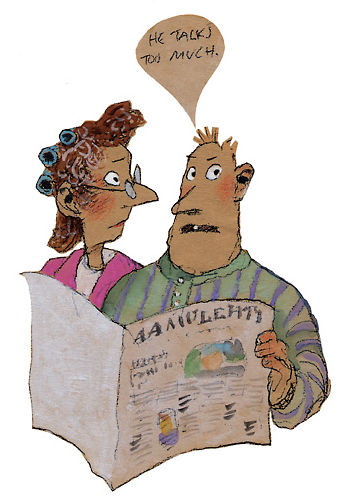
The conception that Finns are a reserved and taciturn lot is an ancient one and does not retain the same validity as it used to, certainly not with the younger generations. Nevertheless, it is fair to say that Finns have a special attitude to words and speech: words are taken seriously, and people are held to what they say. “Take a man by his words and a bull by its horns,” says a Finnish proverb. A Finn will carefully consider what he (or she) says and expect others to do so too. He (or she) considers verbal agreements and promises binding, not only upon himself but upon the other party too, and he (or she) considers that the value of words remains essentially the same, regardless of when and where they are uttered. Visitors should remember that invitations or wishes expressed in a light conversational manner (such as: “We must have lunch together sometime”) are often taken at face value, and forgetting them can cause concern. Small talk, a skill at which Finns are notoriously lacking, is considered suspect by definition, and is not especially valued.
Finns rarely enter into conversation with strangers, unless a particularly strong impulse prompts it. As foreigners often note, Finns are curiously silent in the metro, the bus or the tram. In lifts, they suffer from the same mute embarrassment as everyone else in the world. However, a visitor clutching a map will have no trouble in getting advice on a street corner or in any other public place, since the hospitality of Finns easily overrides their customary reserve.
Finns are better at listening than at talking, and interrupting another speaker is considered impolite. A Finn does not grow nervous if there are breaks in the conversation; silence is regarded as a part of communication. Finns usually speak unhurriedly, even in their mother tongue (the pace of newsreading on Finnish TV is a source of amusement for many foreigners), and although many Finns are competent in several foreign languages, they may be wary of the speed at which these languages are spoken. Nevertheless, Finns can become excited and voluble, given the right situation.
Having once got to know a stranger moderately well, Finns are quite willing to discuss any topic; generally not even religion or politics are taboo. Finland is one of the world’s leaders in the reading of books and newspapers and the use of libraries, and thus the average Finn is fairly well informed on what is happening in Finland and in the world. Finland’s membership of the EU has increased interest in other EU countries, and the common currency, the status of agriculture and the effects of Community legislation are viable topics of conversation wherever two or three Union citizens come together. Though Finns enjoy bitching about the niggling directives of ‘Brussels bureaucrats’ as much as the next man, in general they seem to approve of EU membership and recognise its benefits.
Shared hobbies are a natural topic for conversation and exchange of opinions in Finland as elsewhere, and it can be easy to strike up a lively conversation with a Finn about culture and the arts on the one hand and about sports on the other. Sports is a particularly feasible topic because in recent years Finns have enjoyed success in sports other than the traditional long-distance running and winter sports: there are now world-class Finnish footballers, racing drivers and alpine skiers, and consequently amateurs and enthusiasts in these fields too. Golf has established itself securely especially among urban Finns, even though they are obliged to abandon this pastime for the winter months. This deprivation is an eminently suitable topic for conversation on the part of a visitor who is familiar with the world of drivers and putters.
Information technology
The now ubiquitous mobile phone is revolutionizing the image of Finnish communication skills. The persistent, supposedly amusing ringing tones of the phones demonstrate how eager people are to talk to each other, especially when they are not face to face. One foreign journalist described a scene that he considered typically Finnish: a lone man sitting in a bar with a beer and speaking into a cell phone. A Finnish version of small talk? Communication without intimacy?
The use of mobile phones is governed in Finland, as indeed in other countries, by a loosely defined etiquette which forbids their use if disruptive or dangerous, so using a mobile phone is completely forbidden on aeroplanes and in hospitals. During meetings it is inappropriate. In pubs and restaurants it may be regarded by many as irritating but it goes on regardless. At concerts, at the theatre and in church it is barbaric and considerate people switch their phones off in those places.
Mobile phones have no doubt changed visitors’ perceptions of Finland. Whereas a few decades ago a visitor might report back home on an uncommunicative, reserved and introvert Arctic tribe, the more common view today is that of a hyper-communicative people who are already experiencing the future that some fear and others hope for: a society where anyone can reach anyone else, no matter where or when.
All over the world, the Internet and e-mail have radically changed how people find information and keep in touch, and Finland is no exception. For young people, using the ever-increasing range of IT applications is commonplace, and it is also an important factor in shaping youth culture. Increasingly, politicians and corporate managers set up websites and maintain personal blogs to comment publicly on their lives and views.
Languages
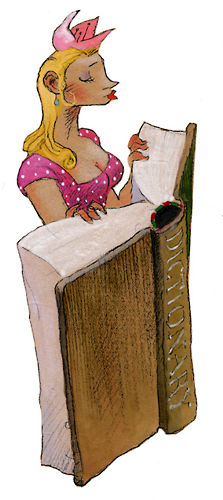
A Finn’s mother tongue is either Finnish, Swedish (5.6% of the population are Swedish speakers) or Saami (some 8,000 native speakers). Finnish belongs to the small Finno-Ugrian language group; outside Finland it is understood (and to some extent spoken) in Estonia. And in Sweden, too, Finnish is spoken among the large number of Finnish immigrants. Finns take care of their linguistic communication by maintaining a wide range of foreign languages in the school curriculum.
English is widely spoken in Finland and in the business community some companies use it as their house language. German is no longer widely taught but many Finns in their 50s or older learned it as their first foreign language at school. French, Spanish and Russian have grown in popularity both in schools and among adult learners. Membership of the European Union and the related practical and social demands have increased the need to study European languages, at least in the case of Finns who travel in Europe on business or are studying abroad.
Educated Finnish speakers, particularly those working in the public sector, speak Swedish to some degree whilst almost all Swedish-speaking Finns speak Finnish too. Only in some coastal areas and in the autonomous province of the Åland Islands is Swedish the dominant language, indeed in Åland it is the only official language. The status of Swedish as the joint official language of mainland Finland can be seen in the bilingual names of public institutions and in street signs, the latter case depending on the percentage of minority language speakers resident in a given municipality, and in the Swedish-language programmes on radio and TV. Swedish-speaking Finns have a distinctive culture, and their social mores are influenced by Scandinavian traditions moreso than amongst the Finnish-speaking majority.
Names and titles
When introducing themselves, Finns will say their forename followed by their surname. Women who use both their maiden name and their husband’s surname will state them in that order. Although Finns are conscious and proud of any official titles they may have, they rarely mention these when introducing themselves. In contrast, they do expect to be addressed by their title in professional and official contexts: Doctor Virtanen, Managing Director Savolainen, etc. Foreigners, however, are not expected to follow this practice, with the exception of the titles “doctor” and “professor” if these are known to the speaker. Otherwise, foreigners can safely address Finns using the English practice of calling them Mr, Mrs, Miss, Ms, Sir or Madam, as appropriate.
The familiar form of address in Finnish (i.e. the second person singular pronoun sinä, as opposed to the formal second person plural pronoun te) is commonly used, not just between friends and acquaintances but among strangers too. It is usual nowadays for people in a workplace to address each other as sinä, up to and including senior management, at least in larger workplaces. Using sinä is common today in service occupations, too, although older people may resent the implied familiarity. However, young people still tend to address middle-aged or elderly people by the formal second person plural if they do not know the persons well.
Although the use of the familiar sinä is common, using first names requires a closer relationship. It is relatively easy to get onto first-name terms with a Finn, especially if it is evident that the parties will continue to meet regularly for business or pleasure. However, it is felt appropriate that the use of first names is specifically and mutually agreed upon. The use of first names is always proposed by the older or more senior person to the junior, or, in the case of equals, by the woman to the man; the agreement is enacted by shaking hands, making eye contact, with each party saying their first name aloud, and nodding the head. Raising a toast with schnapps, wine or champagne lends a festive air to the occasion.
Apart from this, Finns are not nearly as demanding in remembering names as many other people are. It is not usual to address people by name when greeting them (regardless of how familiar one is with them) or in the course of a normal conversation. Addressing by name has trickled into Finnish culture from the American practice, but as nice as it is to hear one’s name spoken, Finns will not be offended if they are not addressed by name.
Businessmen and persons in public office are expected to distribute business cards as a means of ensuring their name and title are remembered. There are no special rituals related to exchanging business cards in Finland. For a visitor, receiving a business card provides a convenient opportunity to ask how a name is pronounced or what a cryptic title might mean.
Greeting
When greeting, the parties shake hands and make eye contact. A deep bow denotes special respect – in normal circumstances, a nod of the head is enough. A Finnish handshake is brief and firm, and involves no supporting gestures such as touching the shoulder or upper arm. When greeting a married couple, the wife should be greeted first, except on a formal occasion where the hosts should first be greeted by the spouse to whom the invitation was addressed. Children are greeted by shaking hands too. Embracing people when greeting them is rare in Finland. A man greeting someone in the street should raise his hat; in the cold of winter, a touch of the hand to the brim of the hat is enough.
Finns can kiss as well as the next nation, but they rarely do so when greeting. Hand-kissing is rare. Friends and acquaintances may hug when meeting, and kisses on the cheek are not entirely unknown, although this habit is not generally found in rural areas. There is no special etiquette regarding the number of kisses on the cheek; however, most Finns feel that three kisses is going a bit far. Men very rarely kiss each other in greeting, and never on the mouth in the manner of our eastern neighbours.
Eating
Finnish cuisine has western European, Scandinavian and Russian elements. Table manners are European. Breakfast can be quite substantial. Lunch is usually eaten between 11:00 and 13:00, a typical lunch break at work lasting less than an hour. The once common long business lunches have shrunk to 90 minutes or two hours. Evening meals at home are eaten around 17:00 or 18:00. In most restaurants, dinners are served from 18:00 onwards. Many restaurants stop serving food about 45 minutes before they actually close, so it is worthwhile checking the serving times when booking a table. Concerts and theatre performances usually begin at 19:00, and audiences adjourn to restaurants at around 22:00.
Restaurant menus and home cooking rarely involve food that western visitors would not be acquainted with. Increased nutritional awareness has made the once heavy, fatty Finnish diet lighter, and the better restaurants can cater for a variety of dietary requirements. Ethnic restaurants, constantly increasing in number, have added to the expanding choice. Beer and wine are drunk with restaurant food in the evening, but at lunchtime these days they feature very little, if at all.
At a dinner party, the host determines the seating order if necessary. The guest of honour is seated to the right of the hostess (or the host, if it is a men-only dinner). This is a seat dreaded by most Finns, since the guest of honour is expected to say a few words of thanks to the hosts after the meal. Guests should not begin to eat until everyone has been served; usually, the host will propose a toast at the beginning of the meal, wishing his guests hyvää ruokahalua, the Finnish for bon appétit! It is not appropriate for guests to drink before this, unless the beginning of the meal is badly delayed.
Finns seldom make speeches during a meal, but they do so on formal occasions. In such cases, the speeches are made between courses. During the meal, the host may toast individual guests, or guests may toast each other, by raising their glasses and making eye contact. Once the toast is drunk, eye contact should be made again when lowering the glass to the table.
A meal normally concludes with coffee and postprandial drinks are served with it or immediately after. If the hosts allow smoking, this is the moment to bring out the cigars and cigarettes, unless of course the host has already allowed or suggested this earlier. When leaving the table, the guests should thank the hosts briefly for the fare when they get the chance, regardless of whether the guest of honour has done so or not.
Drinking
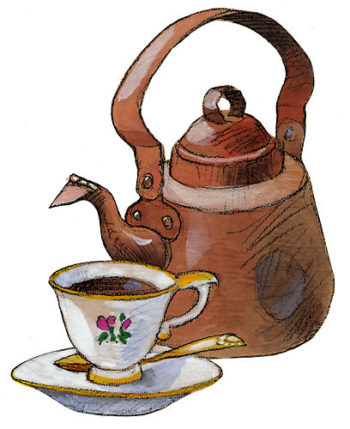
Finns consume the equivalent of slightly over ten litres of pure alcohol per person per year, which is close to the European average. Drinking habits mainly follow Scandinavian and European practices.
However, consumption of wine and beer, as opposed to spirits, has increased in recent years, and as a result more decorous drinking behaviour has become more common. Consumption of alcohol at lunchtime is less common in the business world than it used to be, and in the public sector it is extremely rare.
Alcohol consumption varies somewhat, according to socio-economic differences and, to some extent, by region. The influence of central European or Mediterranean drinking habits is primarily visible among urban middle class young adults and slightly older Finns with tertiary education.
The import and sale of wines and other alcoholic beverages is largely controlled by the state-owned Alko organisation, and private individuals can only buy alcoholic beverages in Alko shops, with the exception of medium strength beer and cider, which can be bought in food stores. Alko is a major buyer of wines and stocks a wide and geographically representative selection of all qualities, including top labels. Many restaurants import their own wines directly from suppliers abroad.
In households wine is normally reserved for weekend meals, but meals prepared for guests or eaten in a restaurant usually involve wine. Often – and in the case of Swedish-speaking Finns, almost always – a meal is preceded by schnapps, a shot of vodka or aquavit in a tiny glass. This is considered an integral part of cold fish courses, and absolutely essential with crayfish. Swedish-speaking Finns have a custom of enlivening the occasion with a line or two of a drinking song before each shot of schnapps. Big dinner parties have an appointed toastmaster who determines the interval between shots and leads the singing. Finnish-speaking Finns have a less elaborate and less structured drinking etiquette, although there are schnapps songs in Finnish too. Schnapps is usually accompanied by mineral water, or sometimes beer, which is also commonly served with meals. Beer is also used to slake the thirst created by the sauna.
Visitors can approach Finnish drinking customs as they see fit. It is not necessary to drink a shot of schnapps in one gulp even if your neighbour does. So it is enough to raise the glass to one’s lips without swallowing. It is also perfectly acceptable to request mineral water or non-alcoholic wine with a meal. Lunch is usually accompanied by non-alcoholic beverages in any case, and non-alcoholic drinks are usually provided. Abstinence is also supported by legislation; in Finland, the blood alcohol level for drunken driving is very low, and the penalties are severe.
Tipping
Tipping has never fitted very comfortably into the Finnish way of life. This may have originally been due to the traditions of a religion which emphasized frugality; today, the rather blunt reason for not tipping is that the price paid includes any unusual instances of service or politeness i.e. the view taken is that “service is included”. Tipping does nevertheless exist in Finland, and you can feel safe that while nobody will object to being tipped, very few will mind not being tipped.
As a rule, service is included in restaurant bills. However, an extra service charge is often added to bills which are to be paid by a customers’ employers. Those who pay for their own meals and in cash often choose to round the bill up to the nearest convenient figure. This does not require any complicated arithmetic from the customer, as no one cares whether the tip really is 10-15% of the total bill.
Tipping at hotels is fairly rare. If you know that you have caused extra inconvenience for the room cleaner, it would be regarded as an appropriate to leave a tip. Receptionists should be tipped only by long-term guests at the hotel. Like their colleagues across the world, Finnish hotel porters will be glad to be tipped the price of a small beer. It is also OK to leave a few coins on the bar for the bar staff.
Taxi drivers do not expect to get a tip, but customers often pay the nearest rounded up figure to the actual fare. Major credit cards are usually accepted in taxis, and in this case tipping in cash is practical.
If you are the guest of Finnish hosts, you should leave any tipping to their discretion.
Smoking
Smoking has decreased in recent years, and attitudes towards it have become more negative. The law prohibits smoking in public buildings and workplaces and, being generally law-abiding, Finns have adapted to this legislation. Nevertheless, smoking is still quite common, in all age groups. International trends have increased the popularity of cigars amongst a minority of tobacco smokers.
As have many other countries, Finland has banned smoking in most restaurants and other licensed premises completely.
Smokers are expected to be considerate. When invited to a private home, a guest should ask the hosts if they object to smoking, even if there are ashtrays visible. Smokers may be guided to the balcony, which may have the effect of reducing the intake of nicotine considerably in cold weather.
Visiting
The home is to a great extent the focus of social life in Finland – to a greater extent at least than in countries where it is more common to meet over a meal in a restaurant. There are cultural, and also economic, reasons for this. A growing interest in cooking and wines has led to an increase in entertaining in the home. A foreign visitor need have no qualms about being invited into someone’s home; he can expect a fairly relaxed and informal atmosphere, and sending or bringing a bunch of flowers or a bottle of wine for the hosts will be appreciated.
A greater cultural challenge for the visitor is accepting an invitation to one of the innumerable summer dwellings that dot the seashores and lakeshores of Finland. One in four Finns owns a summer cabin, and for many, it is regarded as a second home. Sociologists like to explain that the summer dwelling is a tie that Finns maintain to their rural past; and it is true that many Finns transform into surprisingly competent fishermen, gardeners, farmers, carpenters or foresters when they withdraw to their summer homes.
A guest is not expected to take part in this role-play, at least not actively. On the other hand, he is expected to submit without complaint to the sometimes primitive conditions at the summer residence, since not all of them have electricity, running water, a flushing toilet or other urban amenities Many families consider that even a TV set is incompatible with genuine summer cabin life.
A guest is expected to dress casually but practically when going to a summer cabin. The hosts will have rubber boots, raincoats and windcheaters that are worn as the weather dictates or when going fishing, picking mushrooms or walking in the forest. An experienced guest understands that under these conditions the hosts, particularly the hostess, have to go to a lot of trouble to give the guest an enjoyable stay. Help with routine chores is greatly appreciated: peeling the potatoes or the onions is a job the guest can safely offer to undertake.
The best reward for the hosts is that guests enjoy themselves, rain or shine. As for correctness, it would be polite for a guest to raise the question of departure at breakfast time on the third day, and only agree to stay longer if the hosts protest with particular conviction.
Time and the seasons
Although seasons occur everywhere, in Finland they mark the progress of the year with striking conspicuousness. Extending far beyond the Arctic Circle, Finland enjoys such extremes of temperature and daylight that it would not be too far-fetched to say that there are two cultures in Finland: one dominated by the almost perpetual daylight of the summer sun and surprisingly high temperatures, and the other characterized by mercilessly cold winters and Arctic gloom that only briefly gives way to twilight during the day.
Even though summer comes every year, it is considered so important that virtually the entire country ‘shuts down’ for the five or six weeks that follow Midsummer, which falls in late June. After Midsummer, Finns move en masse to their vacation homes in the countryside and those who do not spend their time out of doors, in street cafés and bars, in parks and on beaches, being social and feeling positive. Business and personal correspondence may be temporarily shelved, e-mails cheerfully return ‘out of the office’ notifications for a month or more, and conversations between acquaintances revolve more around how the fish are biting or how the garden is doing than around important issues of international politics or the economy. It is easy for a visitor to observe that in summer Finns are especially proud and happy to be Finns and to live in Finland, and encouraging these feelings is welcome.
With the advent of winter, Finns close down their summer dwellings, store their boats in dry dock, put snow tyres on their cars, stash their golf gear in the basement and check their skis. Whereas the rural ancestors of today’s Finns whiled away the long winter days in making and repairing tools for summer, their descendants labour in offices to make their country an increasingly efficient and modern high-tech marvel.
Finns are punctual people and, in one sense, prisoners of time. As is the case elsewhere in the world, those holding the most demanding jobs have tight daily schedules; missing appointments can cause anguish. Agreed meeting times are scrupulously observed, to the minute if at all possible, and being over 15 minutes late is considered impolite and requires a brief apology or an explanation. Concerts, theatre performances and other public functions begin on time, and delays in domestic rail and bus traffic are rare.
In general, busy lifestyles have come to stay and a diary full of meetings and negotiations is a matter of pride and a status symbol in Finland rather than a demonstration of poor scheduling. In such an environment, the time allocated for the entertaining of guests is one of the most important indicators of the value attached to the occasion. When a Finn stops glancing at his watch and suggests something more to eat or drink, or even a sauna, the visitor can rest assured that a lasting business relationship, or friendship, is on the cards.
Festivals

Finns like celebrations and Finland’s calendar of official festivals is not very different from that of other European countries. One major difference is that the Protestant Lutheran calendar does not accommodate all the feast days of Catholic tradition. Visitors may find it strange that Finns have calm and serious festivities on occasions that would be boisterous and joyful in continental Europe.
Christmas, and Christmas Eve in particular, is very much a family festival in Finland, usually spent at home or with relatives. Customs include lighting candles by the graves of deceased family members. Finns wish each other ‘Merry Christmas’, but equally often they say ‘Peaceful Christmas’. Christmas Day is generally a quiet day and Christmastide social life does not restart until Boxing Day.
December 6 is Independence Day, an occasion marked with solemn ceremonial observances. It is a day for remembering those who fell in the wars to protect Finland’s independence, which was achieved in1917. In the evening, the President of the Republic hosts a reception for some 2,000 guests – including the diplomatic corps accredited to Finland – and watching this reception on TV has evolved into a favourite pastime for the entire nation.
In wintertime, Shrove Tuesday is just about the only festive occasion where public merrymaking can be observed, though even this is not even a pale reflection of the carnivals held in more southerly lands. Logically enough, the most flamboyant annual parties in Finland occur at a warmer time of year. May Day, internationally a festival day for workers and students, can with justification be described as a northern version of Mardi Gras, and Midsummer – the ‘night of no night’ – is an occasion for uninhibited rejoicing, as for most Finns it marks the beginning of summer holidays and a move to the summer dwelling in the countryside.
The sauna

A nation of five million people with 1.5 million saunas has no need to acquire a formal sauna education – learning to bathe in the sauna comes as naturally as learning to speak. Visitors would do well to have their first encounter with the sauna in the company of a Finnish friend or acquaintance, rather than following a mechanical set of instructions that reduces sauna bathing to a drill by numbers.
In Finland, both men and women bathe in the sauna, but never together except within the family. There are no mixed public saunas in Finland. A visitor hesitant about having a sauna should remember that if it has been heated specially for him or her, it is a matter of pride for the hosts, and only medical constraints are an acceptable reason for not trying it.
Having a sauna is something natural to all Finns, yet people do have their own ways of bathing in the sauna. But Finn would never say to another that he is ‘doing it wrong’. It is a matter of preference. This is a good principle to follow for the visitor too: listen to your own body and follow your own rhythm in moving between the hot room, the washing room and the open air, perhaps including the lake or the sea. It is helpful to follow what others are doing, but avoid extremes: some Finns feel the need to demonstrate their tenacity by sitting in a scalding hot sauna for inordinately long periods. In such a situation, a wise visitor will quietly slip out to consume some liquid and enjoy the scenery. On the other hand, it can be equally rewarding to surrender to unknown rituals with an open mind. The feeling of being slapped on the skin with a bundle of soft birch leaves in the heat of the steam room can be a pleasant therapeutic experience.
The sauna is no place for anyone in a hurry. When the bathing is over, it is customary to continue the occasion with conversation, drinks and perhaps a light meal. A guest’s comments on the sauna experience will be listened to with interest, After all, this is a subject that Finns never tire of talking about.
By professor Olli Alho, November 2002, updated March 2010
Illustrations by Mika Launis
